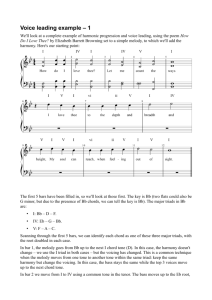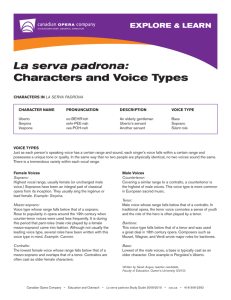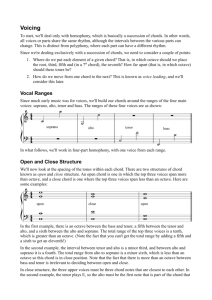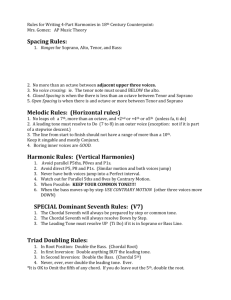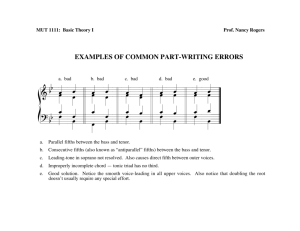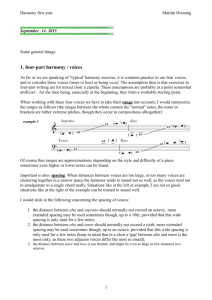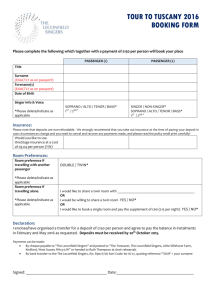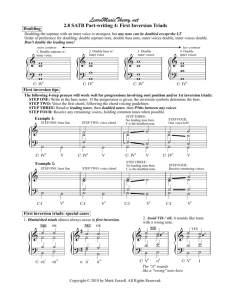lhs music theory homework 4b.319-351a
advertisement
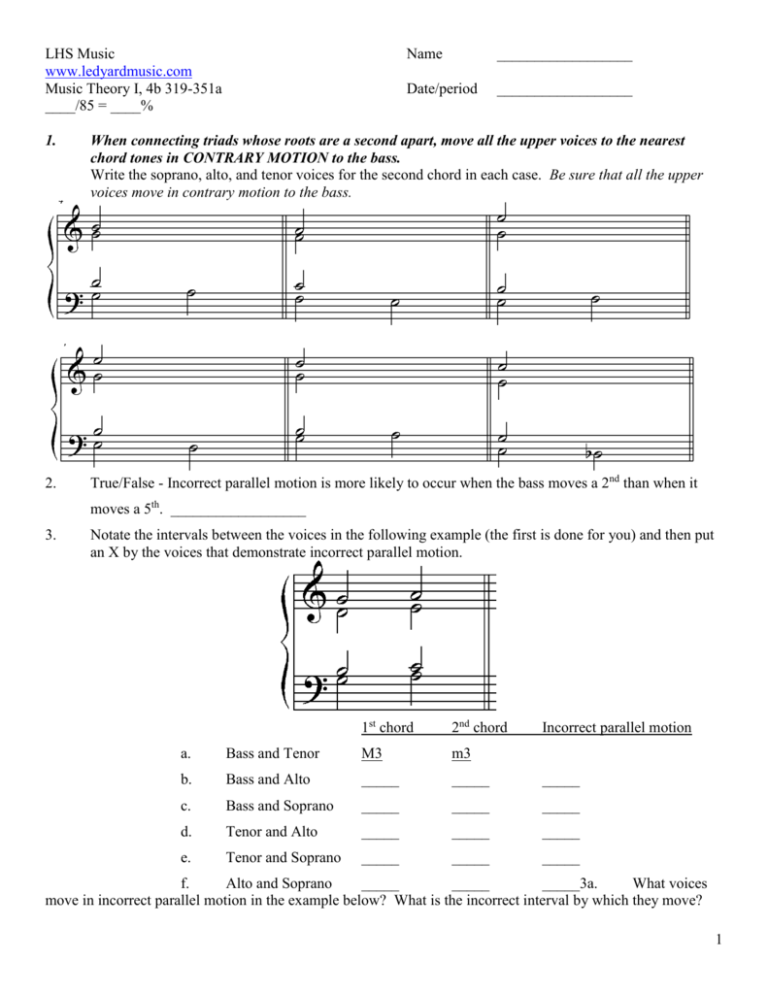
LHS Music www.ledyardmusic.com Music Theory I, 4b 319-351a ____/85 = ____% Name __________________ Date/period __________________ 1. When connecting triads whose roots are a second apart, move all the upper voices to the nearest chord tones in CONTRARY MOTION to the bass. Write the soprano, alto, and tenor voices for the second chord in each case. Be sure that all the upper voices move in contrary motion to the bass. 2. True/False - Incorrect parallel motion is more likely to occur when the bass moves a 2nd than when it moves a 5th. __________________ 3. Notate the intervals between the voices in the following example (the first is done for you) and then put an X by the voices that demonstrate incorrect parallel motion. 1st chord 2nd chord Incorrect parallel motion a. Bass and Tenor M3 m3 b. Bass and Alto _____ _____ _____ c. Bass and Soprano _____ _____ _____ d. Tenor and Alto _____ _____ _____ e. Tenor and Soprano _____ _____ _____ f. Alto and Soprano _____ _____ _____3a. What voices move in incorrect parallel motion in the example below? What is the incorrect interval by which they move? 1 Voices ______________________ Interval ______________________ 4. Write the alto and tenor voices and supply the Roman numeral analysis. Use CLOSE structure for all chords. (The soprano note, beat one, measure 2 should read C not B flat as written) F: 5. _____ _____ _____ _____ _____ Write the alto and tenor voices and supply the Roman numeral analysis. Use OPEN structure for all chords. e: _____ _____ # # _____ _____ _____ 2 5a. What irregularity occurs in the second chord? __________________________________________ 6. When the bass moves UP a second one voice may move in parallel thirds (or tenths) with the bass resulting in a doubled third in the second chord. Which of the examples below demonstrates the above principal? Look for a doubled third in the second chord. _________ a. b. c. 6a. Write the soprano, alto, and tenor voices for the second chord in each case. Be sure that the third is doubled in the second chord. 6b. Write the soprano, alto, and tenor voices for the second chord in each case. Be sure that the third is doubled in the second chord. b # # b5 3 7. When progressing from V to VI in harmonic minor, the second chord will usually contain a doubled third to avoid an A2. Write the alto and tenor voices and supply the Roman numeral analysis. Be sure that the third is doubled in the final chord. # a: _____ 8. _____ _____ _____ Write the alto and tenor voices and supply the Roman numeral analysis. Remember to use irregular doubling when moving from V to VI. # g: 9. _____ _____ _____ # _____ _____ _____ When connecting triads whose roots are a third apart retain two common tones and move the remaining voice to the nearest chord tone. Write the soprano, alto, and tenor voices for the second chord in each case. Be sure to retain two common tones in the same voice. 4 9a. Write the soprano, alto, and tenor voices for the second chord in each case. Be sure to retain two common tones in the same voice. 10. Write the alto and tenor voices and supply the Roman numeral analysis. F: 11. _____ _____ _____ _____ Write the alto and tenor voices and supply the Roman numeral analysis. (Take care to avoid having an A2 in any voice between the last two chords.) a: _____ 11a. _____ _____ _____ # _____ _____ Write the alto and tenor voices and supply the Roman numeral analysis. D: _____ _____ _____ _____ _____ 5 12. When the bass moves UP a third, one voice may move in parallel thirds (or tenths) with the bass resulting in a doubled third in the second chord. Write the soprano, alto, and tenor voices for the second chord in each case. (Remember: the third must be doubled in the second chord.) #5 12a. Write the alto and tenor voices and supply the Roman numeral analysis. (Soprano note, measure 2, beat 1, should read as F not E as written) C: ____ 13. ____ ____ ____ ____ Write the alto and tenor voices and supply the Roman numeral analysis. (Be alert when partwriting the last two chords.) # e: _____ _____ _____ _____ _____ 6 13a. Irregular doubling should not occur in several chords in succession. Return immediately to normal doubling after a chord in which irregular doubling occurs. Write the alto and tenor voices and supply the Roman numeral analysis. Irregular doubling will occur at the asterisk. Take care that doubled tones are left in contrary motion. * G 14. ____ ____ ____ ____ ____ Write the alto and tenor voices and supply the Roman numeral analysis. (Irregular doubling will occur at the asterisk. Return to normal doubling immediately.) * A: _____ _____ _____ _____ _____ 7

